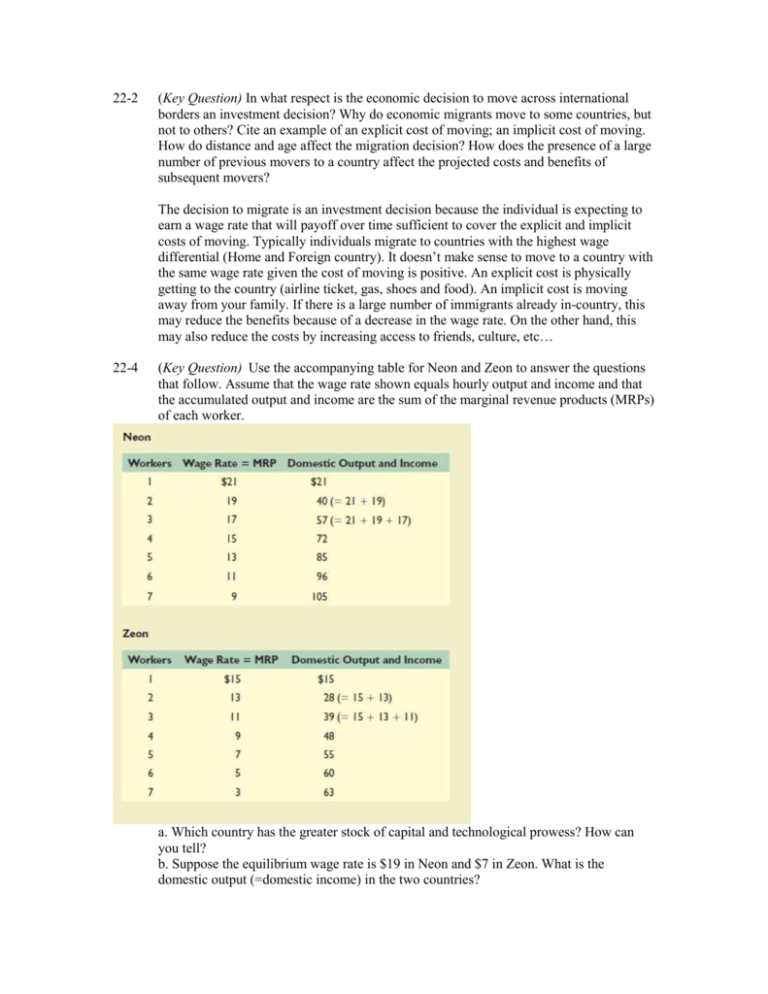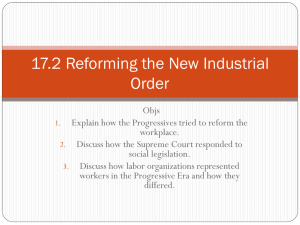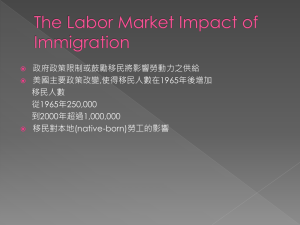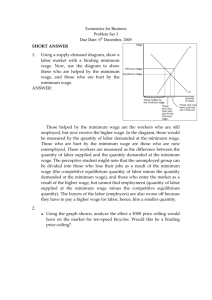Chapter 22 Key Question Solutions
advertisement

22-2 (Key Question) In what respect is the economic decision to move across international borders an investment decision? Why do economic migrants move to some countries, but not to others? Cite an example of an explicit cost of moving; an implicit cost of moving. How do distance and age affect the migration decision? How does the presence of a large number of previous movers to a country affect the projected costs and benefits of subsequent movers? The decision to migrate is an investment decision because the individual is expecting to earn a wage rate that will payoff over time sufficient to cover the explicit and implicit costs of moving. Typically individuals migrate to countries with the highest wage differential (Home and Foreign country). It doesn’t make sense to move to a country with the same wage rate given the cost of moving is positive. An explicit cost is physically getting to the country (airline ticket, gas, shoes and food). An implicit cost is moving away from your family. If there is a large number of immigrants already in-country, this may reduce the benefits because of a decrease in the wage rate. On the other hand, this may also reduce the costs by increasing access to friends, culture, etc… 22-4 (Key Question) Use the accompanying table for Neon and Zeon to answer the questions that follow. Assume that the wage rate shown equals hourly output and income and that the accumulated output and income are the sum of the marginal revenue products (MRPs) of each worker. a. Which country has the greater stock of capital and technological prowess? How can you tell? b. Suppose the equilibrium wage rate is $19 in Neon and $7 in Zeon. What is the domestic output (=domestic income) in the two countries? c. Assuming zero migration costs and initial wage rates of $19 in Neon and $7 in Zeon, how many workers will move to Neon? Why will not more than that number of workers move to Neon? d. After the move of workers, what will the equilibrium wage rate be in each country? What will the domestic output be after the migration? What is the amount of the combined gain in domestic output produced by the migration? Which country will gain output; which will lose output? How will the income of native-born workers be affected in each country? (a) Neon. Neon produces more per worker. (b) Output in Neon is 57 because the equilibrium wage rate is $17. Recall that equilibrium is where MRP=MFC (or MRP=equilibrium wage rate). Using the same logic Zeon’s output is 55. (c) In equilibrium, without migration, 2 workers are employed in Neon and 5 workers are employed in Zeon. If three workers leave Zeon (those employed) the wage rate will rise to $13. These three additional workers will cause the wage to fall to $13 in Neon. Thus, only three workers will move since any more movement would give them a lower wage than they can earn in their home country (Zeon). (d) The equilibrium wage rate will be $13 in both countries. Output in Neon will be 85 and in Zeon 28. Total Output (sum of both countries) was 40+55=95. After migration Total Output is 85+28=113. Thus, the gain in output is 113-95=18. Obviously Neon gains and Zeon loses. Income will fall in Neon and rise in Zeon. 22-5 (Key Question) How might the output and income gains from immigration shown by the simple immigration model be affected by (a) unemployment in the originating nation, (b) remittances by immigrants to the home country, and (c) backflows of migrants to the home country? (a) If there is unemployment in the originating nation output may not fall after some migrate abroad because these workers may have been already idle (jobs may also be filled by the unemployed if someone working decides to migrate). (b) Income may not fall in the immigrants’ country, or at least not as much, because some of the income earned abroad is being sent home. (c) The change in output may not be severe because individuals return to the home country. 22-9 (Key Question) Why is each of these statements somewhat misleading? (a) “Illegal immigrants take only jobs that no American wants.” (b) “Deporting 100,000 illegal immigrants would create 100,000 job openings for Americans.” Both of these statements are misleading. (a) Illegal immigrants probably do lower wages by increasing the supply of unskilled workers, thus some jobs that native-born unskilled workers are displaced and/or receive lower wages. (b) This is also misleading because if we deport 100,000 illegal immigrants the supply of unskilled labor will decrease. This will cause wages to rise and the quantity of labor demanded to fall, so not all of the ‘100,000 jobs’ will still be available.








